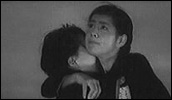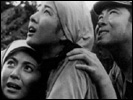Monument to the Girls’ Corps
- Year
- 1968
- Original title
- Aa Himeyuri no To
- Japanese title
- あゝひめゆりの塔
- Director
- Cast
- Running time
- 125 minutes
- Published
- 27 May 2007


by Tom Mes
Mark Schilling's recent book No Borders, No Limits: Nikkatsu Action Cinema details the inner workings of the program picture department at Japan's oldest film studio during the 1950s and 60s. Such quickly-made genre movies, which served as vehicles for a succession of matinee-idol type stars like Yujiro Ishihara and Akira Kobayashi, were released on double bills and formed the lion's share of most major studios' release rosters. While our perception of Golden Age Japanese cinema is still largely limited to the obligatory triumvirate Kurosawa-Ozu-Mizoguchi, none of whom could remotely be considered program picture directors, Schilling's tome redressed this thoroughly off-center balance, introducing us to stars and directors that are household names in Japan but rarely mentioned in the works of Western film historians.
The Nikkatsu studio made more than just youth films and action movies, however. Where most of its program pictures were shot on short schedules and low budgets, its A-list material (which included the films of Shohei Imamura and Yuzo Kawashima) was given considerably larger means. Director Toshio Masuda came from among the B-ranks, but after being assigned to direct his first film with the studio's top star, Yujiro Ishihara, he scored a string of hits that gave him the trust of his bosses.
Monument to the Girls' Corps gives an indication of the reach of that trust. An ambitious World War II drama, complete with battlefield scenes and fighter planes screeching overhead, it chronicles one village's efforts in the defense of Okinawa against the Allied invasion in the spring of 1945. In a battle that lasted from March to June of that year, the entire civilian population was drilled by the military to aid in defending the islands. The story, previously brought to the screen by director Tadashi Imai in 1953 as The Tower of Lillies (Himeyuri no To), focuses on a group of high school girls, whom we meet in 1943 at a school rally at which nothing seems the least bit out of the ordinary. They participate in sporting events, smiling and kidding around. But less than a year later, we see them carrying piles of wood to help reinforce the coast against the impending invasion. The tide in the Pacific War has turned and the Americans are on their way. The teenagers gather in groups and practice with bamboo spears, under the guidance of an army sergeant. When the bombs start to fall, they carry and tend to the wounded, but some are sent out into the clear and fall prey to explosions and fighter planes.
The didactic intentions behind Monument to the Girls' Corps are unmistakable. The film opens in contemporary times, at a nightclub frequented by post-war youth who enjoy the affluence but remain in the dark about their country's past. The camera hones in one of them, a young man casually smoking a cigarette in a corner, and asks him: "Do you know what kids your age had to do in the war?" It's Tetsuya Watari who plays the adolescent, and he, like the film's lead Sayuri Yoshinaga, was expressly cast to draw in exactly this generation that was born after the war. Monument to the Girls' Corps is a history lesson, in other words, an attempt to bring some awareness of the past to post-Sun Tribe society, complete with maps and voice-overs that recount Allied progress across the Pacific.
Much of this is done by way of melodrama (one hand won't suffice to count the number of ensemble singing scenes with teary-eyed close-ups), but at least Masuda doesn't shy away from showing soldiers getting their legs sawn off in surgery (with prim Yoshinaga hauled in to hold the offending member), or schoolgirls blowing themselves up with hand grenades because their government's propaganda has convinced them that the foreign invaders are inhuman beasts.
Among the ensemble of schoolgirls in indentical white head scarves only the hawkeyed will likely spot Meiko Kaji, still credited under her birth name Masako Ota. However, as the story progresses, the focus gradually narrows over the course of the running time, down to a quintet of intrepid girls that include Kaji. The weight of the drama, however, is fully on the shoulders of Yoshinaga, who was in every way Kaji's polar opposite, a fresh-faced starlet who would go on to be one of the most in-demand actresses of the next two decades (and is currently making a rather puzzlingly sudden comeback through films such as Isao Yukisada's Year One in the North / Kita no Zero-nen). Masuda also realised the difference between the two, even at this early stage in their careers, and it is fascinating to see how much of their temperament (or rather, the direction in which studio management wished to push them) shines through in the film: When the two girls carry a wounded soldier to his bunk, they implore a former teacher of theirs to move out of the way and let them pass. But the bespectacled man just sits there, muttering that all is lost for Japan. No prizes for guessing which of the two girls steps forward to strike an angry blow across the coward's face.